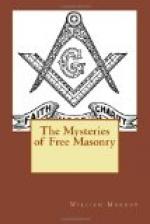To close.—The Grand Master says, “My brother, enter into the cave of Silol—work with Grand Rofadam—measure your steps to the sun, and then the great black eagle will cover you with his wings, to the end of what you desire, by the help of the Most Sublime Princes Grand Commanders.” He then strikes four and two, makes the sign of four squares, which is repeated by the Wardens, and the Lodge is closed.
The examination of a brother in the foregoing degree is as follows:
Q. From whence came you? A. From the sacred vault at Jerusalem.
Q. What are you come to do here? A. I am come to see and visit your works and show you mine, that we may work together and rectify our morals, and, if possible, sanctify the profane—but only by permission of a Prince Adept, or Prince of the Royal Secret (if one is present).
Q. What have you brought? A. Glory, grandeur and beauty.
Q. Why do you give the name of St. John to our Lodge? A. Formerly all the Lodges were under the name of Solomon’s Lodge, as the founder of Masonry; but since the crusades we have agreed with the Knights Templars, or Hospitallers, to dedicate them to St. John, as he was the support of the Christians and the new laws.
Q. What do you ask more? A. Your will and pleasure as you may find me worthy, obedient, and virtuous.
* * * * *
PRINCE OF THE ROYAL SECRET.
The Assembly of Princes is termed a “Consistory.”
Officers.—The first officer represents
Frederick ii., King of
Prussia; he is styled “Sovereign of Sovereigns,”
“Grand Prince,”
“Illustrious Commander in Chief.”
The two next officers are styled
“Lieutenant Commanders.” The fourth
officer is the “Minister of
State,” who acts as the orator. The fifth
officer is the “Grand
Chancellor.” Then the “Grand Secretary;”
the “Grand Treasurer;” the
“Grand Captain of the Guards;” a “Standard
Bearer;” a “Grand Master
Architect;” and two “Tylers.”
Place of meeting.—This is to be a building at least two stories in height, situated on elevated ground, in the open country. Three apartments on the second floor are necessary in this degree. In the first of these the guards are stationed. The second is used as a preparation room. The third is occupied by the members of the Consistory. This last apartment is hung with black, sprinkled with tears, “death’s heads,” “cross bones,” and “skeletons.” The throne is in the East, elevated by seven steps. On the throne is the chair of state, lined with black satin, flamed with red. Before the chair is a table covered with black satin, strewed with tears. On this cloth, in front, is a “death’s head” and “cross bones;” over the “death’s head” is the letter I; and under the “cross bones” is the letter M. On the table is placed a naked sword, a buckler, a sceptre, a balance, and a book containing the statutes of the order. In the West is placed another table covered with crimson, bordered with black, and strewed with tears; on the front of this cloth are the letters N. K. M. K. in gold.




